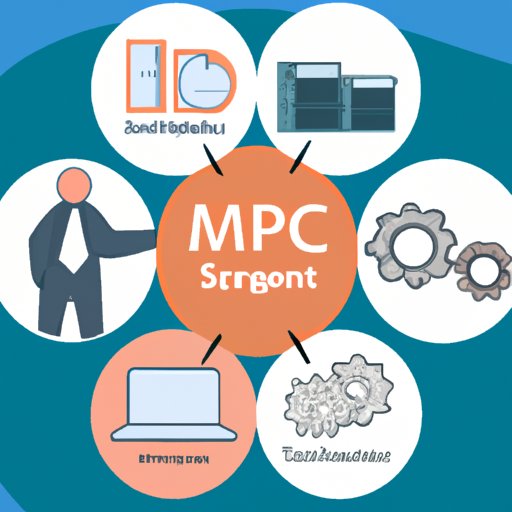Introduction
Managed Service Providers (MSPs) have become an integral part of the modern IT infrastructure. MSPs provide businesses with a wide range of services that help them manage and optimize their IT systems. But what exactly are MSPs and what are the benefits of working with one? In this article, we’ll explore these topics in depth.
Exploring MSP: An In-Depth Look at Managed Service Providers in Information Technology
MSPs are companies that specialize in providing IT services such as data security, system performance, and business continuity. They typically offer a variety of services, from monitoring and maintenance to consulting and development. Let’s take a closer look at what MSPs are and the different types of services they offer.
What is an MSP?
An MSP is a company that provides IT services to organizations on a contract basis. These services can include anything from system monitoring and maintenance to data security and compliance. MSPs are often used by businesses that don’t have the resources or expertise to manage their IT operations internally.
Different Types of MSPs
MSPs come in all shapes and sizes, offering different levels of services depending on the needs of the client. Some of the most common types of MSPs include:
- Cloud MSPs – Cloud MSPs specialize in cloud computing services such as implementation, management, and support.
- Security MSPs – Security MSPs focus on protecting an organization’s data and systems from malicious threats.
- Network MSPs – Network MSPs provide network design, optimization, and monitoring services.
- Backup & Disaster Recovery MSPs – Backup & Disaster Recovery MSPs help businesses prepare for and recover from disasters.
Advantages and Disadvantages of Using an MSP
Using an MSP has both advantages and disadvantages. On the plus side, MSPs can provide the expertise, resources, and flexibility needed to maintain a robust IT infrastructure. On the other hand, working with an MSP can be expensive, and there is always the risk of relying too heavily on outside help.
How Managed Service Providers (MSPs) Help IT Professionals Achieve Their Goals
MSPs can help IT professionals achieve their goals in several ways. Here are some of the most common benefits of working with an MSP:
Assisting with Data Security & Compliance
MSPs can help IT departments ensure that data is secure and compliant with industry regulations. They can do this by implementing best practices and policies, monitoring networks for potential threats, and performing regular audits.
Enhancing System Performance & Efficiency
MSPs can also help improve system performance and efficiency. They can do this by optimizing networks, automating tasks and functions, and leveraging new technologies like cloud computing.
Developing Solutions for Long-Term Success
Finally, MSPs can help IT departments develop solutions for long-term success. They can do this by providing advice and guidance on strategy and planning, helping to upgrade and integrate systems, and enhancing network connectivity and accessibility.

Understanding the Benefits of Working with an MSP in IT
Working with an MSP can provide numerous benefits to organizations. Here are some of the most common:
Time & Cost Savings
MSPs can help organizations save time and money by taking on the responsibility of managing and maintaining their IT systems. This can free up IT staff to focus on more strategic tasks, while reducing overhead costs associated with hiring and training new personnel.
Improved Business Continuity
MSPs can help organizations maintain business continuity in the event of an emergency or disaster. They can do this by providing backup and disaster recovery services, as well as advice and guidance on developing a comprehensive business continuity plan.
Increased Productivity
MSPs can also help organizations increase productivity by streamlining processes and leveraging new technologies. For example, they can help automate manual tasks, implement best practices and policies, and enhance collaboration and communication.
Leveraging Managed Service Providers to Streamline IT Processes
MSPs can help organizations streamline IT processes in several ways. Here are some of the most common:
Automating Tasks & Functions
MSPs can help automate tasks and functions, such as software updates, patch management, and system monitoring. This can free up IT staff to focus on more strategic tasks, while reducing the time and cost associated with manual processes.
Implementing Best Practices & Policies
MSPs can also help organizations implement best practices and policies, such as data security and compliance standards. This can help protect an organization’s data and systems, while ensuring that it meets industry regulations.
Enhancing Collaboration & Communication
Finally, MSPs can help organizations enhance collaboration and communication. They can do this by providing tools and technologies, such as cloud computing and unified communications, that make it easier for teams to work together.

The Role of MSPs in Modernizing IT Infrastructure
MSPs can play an important role in modernizing IT infrastructure. Here are some of the ways they can help:
Upgrading & Integrating Systems
MSPs can help organizations upgrade and integrate their systems. This can involve anything from migrating to the cloud to deploying new hardware and software. MSPs can also provide advice and guidance on selecting the right technologies for an organization’s specific needs.
Enhancing Network Connectivity & Accessibility
MSPs can also help enhance network connectivity and accessibility. They can do this by providing tools and technologies, such as virtual private networks (VPNs), which can improve remote access and performance.
Utilizing Cloud Computing & Other Technologies
Finally, MSPs can help organizations utilize cloud computing and other technologies to their fullest potential. They can do this by providing advice and guidance on best practices, helping to integrate systems, and providing support as needed.

A Guide to Choosing the Right MSP for Your IT Needs
When choosing an MSP, it’s important to consider the following factors:
Identifying Your Needs & Requirements
The first step is to identify your organization’s needs and requirements. This will help you determine the type of services you need and the level of expertise required.
Researching & Comparing Different MSPs
Once you have identified your needs, it’s time to start researching and comparing different MSPs. Be sure to read reviews, ask for references, and get quotes from multiple providers.
Evaluating Customer Service & Support
Finally, it’s important to evaluate an MSP’s customer service and support. Ask about their response times, availability, and any additional services they may offer.
Conclusion
Managed Service Providers (MSPs) are essential for any organization looking to maximize the efficiency and effectiveness of their IT operations. MSPs can provide the expertise, resources, and flexibility needed to maintain a robust IT infrastructure, as well as time and cost savings, improved business continuity, and increased productivity. When choosing an MSP, it’s important to identify your needs and requirements, research and compare different providers, and evaluate their customer service and support.
(Note: Is this article not meeting your expectations? Do you have knowledge or insights to share? Unlock new opportunities and expand your reach by joining our authors team. Click Registration to join us and share your expertise with our readers.)
